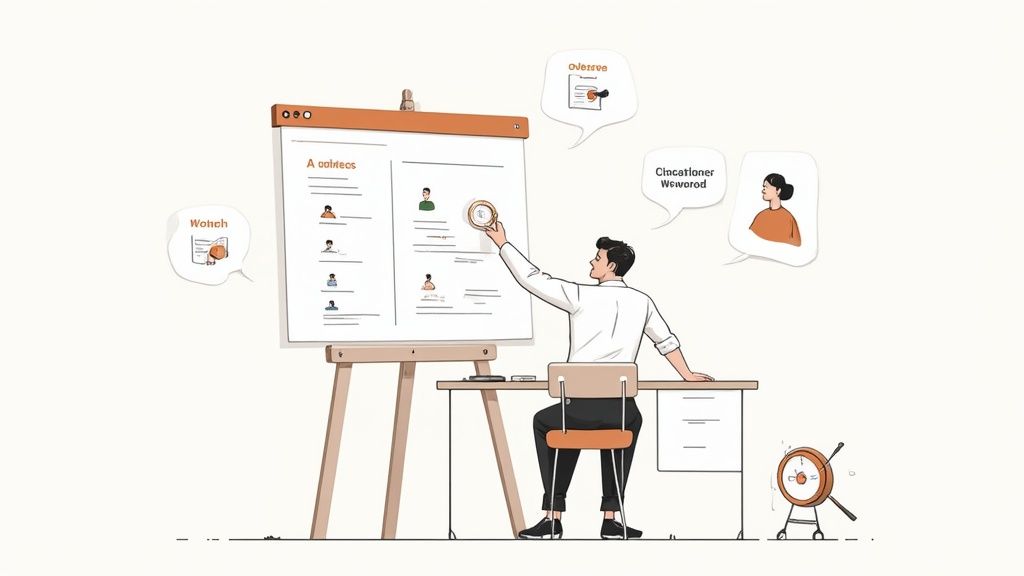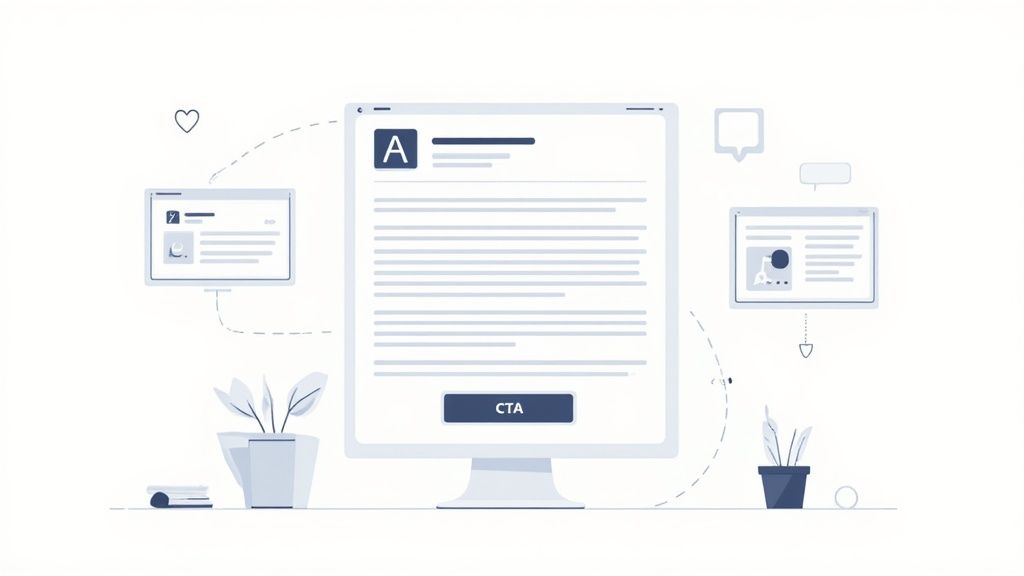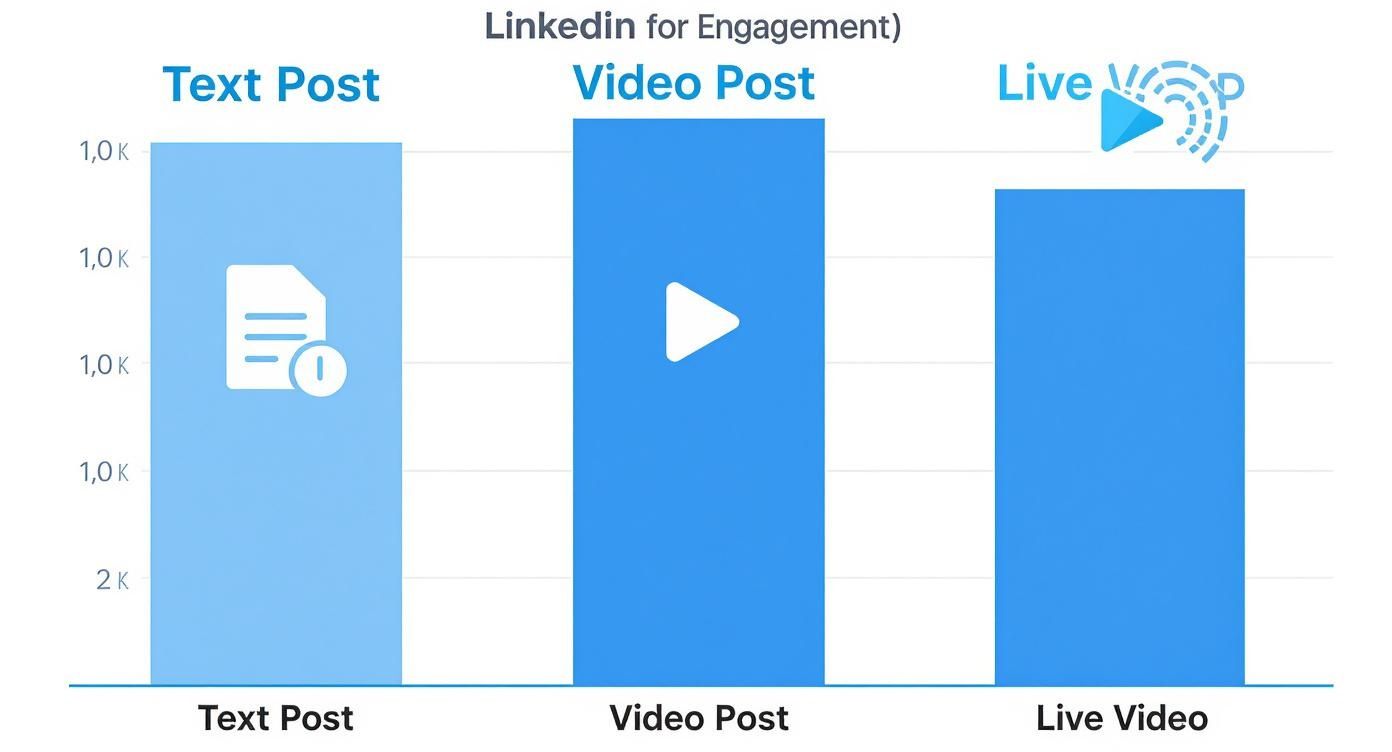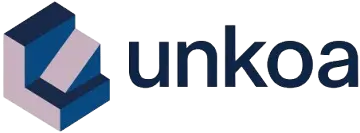How to Write LinkedIn Posts That Get Engagement

Before you even think about writing a single post, we need to lay the groundwork. The best LinkedIn content isn't just winged—it's engineered. It all comes down to a simple, powerful formula: define your audience, get crystal clear on your goals, and figure out what actually works. This strategic foundation is what makes every piece of content you create hit the mark with the right people and deliver real results.
Mastering Your LinkedIn Audience and Goals

Jumping straight into writing without knowing who you're talking to and why you're talking to them is like building a house without a blueprint. Sure, you might end up with something, but it probably won't be very functional or stand the test of time. This prep work is the invisible force that separates memorable, high-engagement posts from the endless noise people scroll past.
Being intentional is the name of the game. A solid plan ensures your efforts are focused, your message is sharp, and your results are something you can actually measure.
Defining Your Target Audience
Knowing your audience is about more than just a job title or an industry. To really connect, you have to get inside their world. What’s keeping them up at night? What are their biggest career goals? What daily frustrations are they dealing with that you can actually solve? Answering these questions turns your content from generic fluff into an indispensable resource.
Here’s how you can dig in and get those answers:
- Analyze Competitor Content: Go find 5-10 influential voices or direct competitors in your space. Dive deep into their best-performing posts. What topics are blowing up the comments? What questions are their followers asking? This is a goldmine for uncovering audience pain points and hot topics.
- Join Relevant Groups: Pop into LinkedIn Groups where your ideal audience hangs out. Don't just lurk—pay close attention to the language they use, the problems they discuss, and the solutions they’re hunting for. It’s a direct line into their mindset.
- Talk to Your Existing Network: If you already have clients or connections who fit your ideal profile, just ask them! A quick chat can reveal more about what they want to see than weeks of guessing ever will.
The key is to organize this intel. I use a simple workspace in a tool like Notion to build out a detailed audience persona. This document becomes my guide for every single post I write. This groundwork is also crucial when you're getting set up; for more on that, check out our guide on https://www.unkoa.com/how-to-create-a-business-profile-on-linkedin-2/.
Setting Clear Content Goals
Every post needs a job to do. Without a clear objective, you're just adding to the noise. Your goals will shape everything—the tone, the format, the call-to-action. They’re the "why" behind your entire content strategy.
Your LinkedIn goals should be specific, measurable, and tied directly to your bigger business objectives. A vague goal like "get more followers" is useless compared to "generate 5 qualified leads per month through my content."
Here are some common goals people focus on:
- Brand Awareness: Getting your name, expertise, and values in front of a wider professional audience.
- Lead Generation: Pushing followers to book a call, download a guide, or ask about your services.
- Thought Leadership: Positioning yourself as the go-to expert by sharing unique, hard-hitting insights.
- Community Building: Creating a loyal tribe by sparking conversations and connecting people in your audience.
Once you’ve locked in your primary goal, you can start aligning your content. For instance, a lead generation goal might mean you post more client case studies with a direct CTA. On the other hand, a thought leadership goal would inspire more analytical, forward-thinking pieces. This alignment ensures every post is a deliberate move toward the results you want.
The Anatomy of a High-Performing LinkedIn Post

A LinkedIn post that actually stops the scroll and starts a real conversation doesn't happen by accident. It’s engineered. It follows a specific structure designed to grab attention, deliver a punch of value, and then push people to act.
Getting this anatomy right is the difference between posting into the void and creating content that consistently delivers.
Every single powerful post is built on three core pillars: the hook, the body, and the call-to-action (CTA). Each one has a job to do. When they all work in harmony, you create an experience that keeps your reader locked in from the first word to the last.
The Irresistible Hook
Honestly, the hook is everything. It's the first one or two lines of your post—the only bit of text people see before they have to click "...see more."
If your hook doesn't instantly spark curiosity or hit a nerve, the rest of your post is dead in the water. Its only job is to make someone pause their endless scroll.
Here are a few hook formulas that just plain work:
- Poke the bear with a question: Challenge a common belief or speak directly to a frustrating pain point. Think, "What if your entire client acquisition strategy is built on a myth?"
- Show a little vulnerability: Authenticity is magnetic. A hook like, "I totally bombed a client call last week, and it was the best thing that could've happened," is human, relatable, and makes people lean in.
- Make a bold, contrarian statement: A surprising claim gets people to stop and think. "Stop setting goals. You need to be building systems instead." That immediately makes someone want to understand your logic.
- Drop them into the middle of the action: Start your story right in the heat of the moment. "The client stared me down and said, 'This is the worst proposal I've ever seen.'" Who wouldn't want to know what happened next?
The whole point is to create an "open loop"—a sense of suspense that the reader feels an urge to close by clicking to read the rest.
The Compelling Body
You've earned the click. Now what? The body of your post has to deliver on the promise your hook made. This is where you unpack the value, tell the story, or share the key insight.
A bold claim is a great start, but you have to back it up with a narrative that's easy to follow. This is where formatting becomes your best friend. Nobody wants to squint at a dense wall of text on their phone.
Key Takeaway: The best LinkedIn posts are written for scanners, not deep readers. Use tons of white space, short paragraphs (1-2 sentences), bullet points, and the occasional emoji to guide the eye and make your main points impossible to miss.
Your post's body should revolve around a single, core idea. Whether you're breaking down a complex topic, sharing a personal story, or walking through some data, keep it focused. A post that tries to do too much at once will lose its punch.
The Powerful CTA
The final piece of the puzzle is your Call-to-Action. You can't just end your post and hope for the best. You need to tell people exactly what to do next. A weak or missing CTA is like leaving money (and engagement) on the table.
Steer clear of lazy CTAs like "What do you think?" Be specific. Make it incredibly easy for someone to chime in.
- Ask for a specific experience: "What's the one tool you couldn't run your business without? Drop it below."
- Invite them to share a story: "That was my biggest lesson from a failed project. What's yours?"
- Prompt a simple choice: "Are you Team A or Team B on this? Let me know in the comments."
A strong CTA turns your monologue into a dialogue. That's precisely what the algorithm is built to reward.
To bring it all together, here's a quick cheat sheet for structuring your posts.
LinkedIn Post Structure Breakdown
This table breaks down each component, its specific job, and how to nail it every time.
| Component | Purpose | Best Practice Example |
|---|---|---|
| Hook | Grab attention and stop the scroll in the first 2 lines. | "99% of founders get this wrong..." |
| Body | Deliver value, tell a story, and prove your point. | Use short paragraphs, bullet points, and bold text to explain the 'what' and 'why'. |
| CTA | Spark conversation and drive a specific action. | "What's the #1 mistake you see in your industry? Comment below." |
| Hashtags | Help your content get discovered by a wider audience. | Mix 1-2 broad tags (#SaaS) with 2-3 niche tags (#B2BContent) at the very end. |
By mastering these four elements, you're not just writing posts; you're building a reliable system for generating meaningful engagement on LinkedIn.
Using Hashtags Strategically
Think of hashtags as your post's discovery engine. They're how people who don't follow you find your content. The key here is relevance, not quantity. Stick to 3 to 5 highly relevant hashtags at the very end of your post.
A smart mix usually looks like this:
- 1-2 Broad Tags: Keywords for your general industry (e.g., #Marketing, #SaaS).
- 2-3 Niche Tags: More specific topics your post actually covers (e.g., #ContentStrategy, #B2BLeadGen).
- 1 Branded Tag (Optional): A unique tag for you or your business (e.g., #UnkoaMarketing).
This simple strategy helps your content land in front of the right eyeballs, expanding your reach without looking spammy. Remember, the LinkedIn algorithm is designed to amplify quality engagement. It tests your post with a small slice of your network, and if it sparks a good conversation, it gets pushed out to a much wider audience. For a deeper dive, learn more about how the algorithm works and why regular posting doubles engagement.
Proven LinkedIn Post Formats That Actually Work
Staring at a blank page is the worst. We've all been there.
Instead of trying to reinvent the wheel every single day, the secret to staying consistent is to lean on a few proven post formats. Think of them as recipes you can adapt with your own voice and industry expertise. They give you a reliable toolkit so you're never starting from a dead stop.
These aren't rigid templates; they're flexible frameworks. Once you get the hang of a few of these, you'll find your content creation speed skyrockets.
The Personal Story with a Business Lesson
Here’s the thing: people connect with people, not logos.
This format is all about linking a personal experience—a failure, a lesson learned, a surprising win—to a universal business insight. It’s incredibly powerful because it builds trust and makes your advice feel genuine and relatable.
The structure is simple:
- Hook: Start right in the middle of the action or with a vulnerable admission.
- Story: Briefly tell the personal story.
- Bridge: Connect that story to a professional takeaway.
- CTA: Ask your audience to share a similar experience.
Here’s an example you can swipe:
"I lost a $10k client last year because I was too proud to ask for help.
I thought I had to have all the answers. I spent weeks trying to solve a problem that was way outside my expertise, and by the time I admitted it, the client's trust was gone.
It was a painful lesson: your value isn't in knowing everything. It's in knowing what you don't know and having the network to fill the gaps. That failure taught me more about collaboration than any success ever could.
What's a failure that ended up teaching you an invaluable lesson?"
This format works because it’s raw and human. It's a fantastic way to show your character while still delivering real business value.
The Contrarian Take
Let's be honest, most LinkedIn feeds are an echo chamber of safe, agreeable opinions.
The contrarian take grabs attention by challenging a widely accepted industry belief. This isn't about being controversial just for clicks; it's about offering a fresh, well-reasoned perspective that actually makes people stop and think.
When you do this right, it positions you as a true thought leader, not just another person repeating the same old advice.
To pull this off, you must back up your bold claim. Use strong logic, data, or a compelling personal anecdote. The goal is to start a thoughtful debate, not a flame war.
For instance, while everyone else is praising "hustle culture," you might write a post titled, "Why 'hustle' is the most toxic word in business." Then, you’d use the body of the post to explain your reasoning, maybe by highlighting the costs of burnout and the upside of building sustainable systems.
The Data-Driven Insight
Numbers cut through the noise. They tell a compelling story all on their own.
This format takes a single, powerful statistic and builds a narrative around it. You explain what that number means for your audience and, most importantly, what they should do about it. This approach instantly adds a layer of credibility and authority to your content.
For example, LinkedIn’s own engagement data from early 2025 shows just how much numbers can shape strategy. The platform averages a 2.8% engagement rate for standard posts, but posts with video see five times more engagement, and live broadcasts get a staggering 24 times more. And while over 1.2 billion people are on LinkedIn, only about 1% post weekly—yet they generate 9 billion impressions every week.
To use this format, find a surprising statistic relevant to your industry. Drop the number right in your hook, then spend the rest of the post unpacking its implications and offering actionable advice. A tool like QuillBot can be a great help here, allowing you to refine your analysis and present your ideas clearly.
If you want to go deeper on this and other strategies, check out our complete guide on the underrated LinkedIn growth hack. This approach turns raw data into a must-read piece of content.
Building a Sustainable Content System
Great LinkedIn content isn't about chasing one-off viral hits. It’s about showing up consistently, day in and day out, over the long haul. But let's be real—for a solo operator, "being consistent" sounds a lot like a one-way ticket to burnout.
The secret isn’t working harder. It’s building a smart, sustainable system that turns content creation from a daily chore into a manageable, powerful asset. A good system removes that dreaded daily pressure of staring at a blank page. Instead of waking up and thinking, "What on earth should I post today?" you'll have a backlog of ideas, a simple workflow, and a clear schedule that works for you.
Finding Your Optimal Posting Cadence
So, how often should you actually post? While quality will always trump quantity, the data shows a clear link between how often you post and how fast you grow. More activity signals to the LinkedIn algorithm that you're an active, valuable member of the community, and it rewards you for it.
A 2025 data-driven study from Buffer really put numbers to this. They found that jumping from just one post a week to 2-5 posts weekly boosted impressions by an average of 1,182 per post and bumped engagement by 0.23 percentage points. The benefits just kept scaling up from there. Posting 6-10 times per week delivered 5,000 more impressions per post and a 0.76 percentage point lift in engagement. The most dedicated users—posting 11+ times weekly—saw a massive 17,000 more impressions per post and a 1.4 percentage point jump in engagement compared to the once-a-week folks. You can dig into the full findings to see how these results held true regardless of audience size.
The takeaway is simple: Posting more often delivers compounding returns. You don't have to post 11 times a week, but aiming for at least 3-5 times a week is the sweet spot for building real momentum without overwhelming yourself.
This chart breaks down how different post formats can perform, which can help you decide where to focus your creative energy.

As you can see, simple text posts are workhorses, but adding video—especially live video—can give your engagement a serious boost.
Designing Your Content Workflow
A reliable workflow is the engine of your entire content system. It breaks the whole process down into small, manageable chunks: coming up with ideas, creating the content, scheduling it, and then repurposing it.
- Ideation (The Fun Part): Block out a bit of time once a month just to brainstorm. No writing allowed. Just jot down topics, questions people ask you, client stories, and random insights. Keep them all in one place—a spreadsheet, a Trello board, whatever works for you.
- Creation (Batch-Writing): This is a game-changer. Set aside a few hours one day a week to write out multiple posts at once. Batching your writing is way more efficient than trying to create a new post from scratch every single day.
- Scheduling (Automation): Once your posts are written, use a scheduling tool to load them up for the week or month ahead. This puts your content on autopilot and frees you up to do the most important thing: engaging with people in the comments.
If you want to go deeper on building an efficient system, check out our guide on the five-step LinkedIn ghostwriter workflow. You can easily adapt it for your own needs.
Leveraging Smart Content Repurposing
This is the ultimate hack for making content sustainable: create once, distribute forever. Repurposing is all about taking one big piece of content and slicing it up into dozens of smaller LinkedIn posts. It saves a ton of time and makes sure your best ideas reach the widest possible audience.
Think about it: a single blog post, podcast episode, or YouTube video is a goldmine of smaller content pieces.
Here are a few practical ways to do it:
- Pull Out Key Quotes: Grab the most impactful, tweet-sized sentences from your content and turn them into simple text-only posts or branded graphics.
- Summarize Core Insights: Condense the main argument of a section into a short, punchy LinkedIn post with a few key bullet points.
- Create Video Snippets: Use a tool like Opus Clips to automatically find the most interesting hooks in a longer video and chop them into short, shareable clips perfect for the LinkedIn feed.
- Turn Stats into Visuals: Found a great data point? Create a simple chart or graphic to make it more digestible and shareable.
- Develop a Carousel (PDF): Break down the steps from a "how-to" guide or listicle into a multi-slide carousel. This format performs incredibly well on LinkedIn.
By building your content plan around a few core "pillar" pieces each month, you can generate a steady stream of high-quality LinkedIn posts without the constant pressure of finding new ideas. Tools like SocialBee are perfect for managing this, letting you schedule and categorize all your repurposed content for consistent publishing. This system-based approach transforms content creation from a source of stress into a powerful, scalable growth engine.
How to Measure and Optimize Your Content Strategy
Creating great content is only half the battle. If you're pouring hours into writing posts without ever looking at the data, you're essentially driving with your eyes closed. You need to know what's working so you can do more of it.
This is where you stop guessing and start making smart, data-backed decisions. By digging into your analytics, you can quit wasting time on content that falls flat and double down on the topics, formats, and hooks that your audience actually craves. This isn't about chasing vanity metrics; it's about fueling real growth.
Pinpointing the Metrics That Matter
LinkedIn gives you a whole dashboard of numbers, but honestly, not all of them are created equal. Likes are nice for a quick ego boost, but they don’t tell you much about the real impact of your content. To get a true sense of what's connecting, you need to look a little deeper.
Here are the key metrics I always track:
- Comments: This is the gold standard. A comment means your post was compelling enough to make someone stop scrolling, think, and actually type out a response. It's a sign of a genuine connection.
- Impressions: This is how many times your post was shown in someone's feed. On its own, it can be a vanity metric. But a big spike in impressions usually means the algorithm liked your initial engagement and is pushing your content to a much wider audience.
- Engagement Rate: This is your total engagements (likes, comments, reshares) divided by your impressions. It gives you a clean percentage of how many people who saw your post actually did something, which is a much truer measure of a post's quality than raw numbers alone.
- Profile Views: A jump in profile views right after a post goes live is a fantastic sign. It shows your content is attracting the right kind of people—those curious enough to click your name and see what you're all about.
Don't get hung up on a high like count if the comment section is a ghost town. A post with 10 thoughtful comments is almost always more valuable than one with 100 passive likes. It signals a much deeper level of engagement.
Conducting a Monthly Content Review
Data is pretty useless if you don't do anything with it. All you need is a simple monthly review to turn those numbers into an actionable strategy. Just set aside 30 minutes at the end of each month to look back at what you posted.
Your goal here is to spot patterns.
I use a simple spreadsheet (a Notion doc works great too) to track my top three and bottom three performing posts for the month.
For each post, I jot down a few notes:
- What was the format? (e.g., personal story, data insight, asking a question)
- What kind of hook did I use? (e.g., vulnerable, contrarian, bold claim)
- What day and time did it go live?
- What was the main topic?
After just a couple of months, you'll start to see clear trends emerge. You might discover your audience absolutely loves your contrarian takes but couldn't care less about simple data posts. Or maybe your Tuesday morning content consistently crushes whatever you post on a Friday afternoon.
This simple, data-driven feedback loop is how you systematically refine your approach and start writing LinkedIn posts that get results, every single time.
Answering Your Lingering LinkedIn Questions
You've got the frameworks, you know the formats, and you have a system ready to go. But what about those nagging little questions that pop up right when you're about to hit "Post"?
Let's clear those up. Getting these details right is what separates a decent LinkedIn strategy from a truly effective one.
What's the "Best" Time to Post on LinkedIn?
Everyone's looking for that magic window, but the truth is, there isn't one. General advice will tell you mid-week during business hours, but your perfect time is hiding in your own data.
Forget the universal advice and dig into your LinkedIn analytics. See when your followers are actually online and engaging. From there, run a few tests. Post at different times for a couple of weeks and see what the numbers tell you.
Ultimately, a consistent schedule you can actually stick to beats chasing a mythical "perfect" time slot every single day.
How Long Should My LinkedIn Posts Be?
There's no hard-and-fast rule, but the sweet spot is usually somewhere between 500 and 1,300 characters. This gives you enough room to tell a compelling story or share a real insight, but it’s still short enough to be easily scanned on a phone.
Your real goal isn't hitting a character count. It's making the first 2-3 lines so ridiculously compelling that people can't help but click "...see more." Always prioritize a powerful hook over arbitrary length.
Should I Bother with Images or Videos?
Yes. Absolutely. Posts with visuals consistently crush text-only updates. Video, in particular, is a powerhouse for sparking comments and conversations.
Use high-quality, authentic images (not cheesy stock photos) or short, subtitled videos to stop the scroll. Another killer format is the carousel, which you can upload as a PDF. It’s perfect for breaking down complex ideas into bite-sized, digestible slides. If you need a hand scheduling different media types, a tool like SocialBee can make your life a lot easier.
How Many Hashtags Are Too Many?
Keep it clean and focused. Stick to 3 to 5 highly relevant hashtags at the very end of your post. Piling on more than that just looks spammy and waters down your message.
A smart approach is to use a mix of broad, niche, and branded tags. This helps you hit different discovery channels.
For example, a post on marketing could use:
- A broad tag like #Marketing
- A niche one like #B2BContent
- Your own branded tag, like #UnkoaMarketing, to start building a community around your content.





